Last week, OSHA issued compliance guidance for its Cranes and Derricks in Construction standard, CPL 02-01-057. The Directive provides compliance guidance to Compliance Safety & Health Officers (CSHO) for inspections of construction employers operating cranes and/or derricks in construction activities. Additionally, the Directive serves as a source of information to employers on how OSHA interprets various requirements in the standard and provides guidance to employers regarding the types of questions OSHA is likely to ask during an inspection and the documentation they are likely to request.
A section of the Directive outlines an “Abbreviated Inspection Checklist” that includes 19 items that compliance officers should consider in an inspection of any worksite with a crane. Some of the items instruct compliance officers to:
1. Determine the adequacy of ground conditions beneath the equipment, such as the support, foundation, cribbing, blocking, etc.
2. Check for visible indications of repairs of the equipment
3. Where overhead power lines are present, ask:
-
If utility owner was contacted
-
If lines are energized
-
The voltage of the power lines (if known)
-
If a work zone was demarcated and what encroachment prevention methods are being used
4. Where signal persons are used:
-
Verify qualifications and documentation (documentation can be electronic or physical copies)
-
Verify the communication system being used between the crane operator and the signal person is the one specified on the qualification documentation
5. Inspect all rigging equipment that is available for employee use (slings, chokers, shackles) for damage, wear, safe working load tags, capacity, and safety factor.
6. Verify the load chart and operations manuals are available, written in language the operator understands.
7. Verify operator qualifications and training. Observe crane operations and interview bothe the employer and the operator to determine whether the operator is competent to operate the equipment safely
8. Verify that crane/derrick and wire rope inspections requirements have been met and documentation, where required, is available.
9. Verify that qualified riggers are being used for assembly and disassembly work and when employees are within the fall zone and hooking, unhooking, guiding a load, or making the initial connection of a load to a component or structure.
In addition to the Abbreviated Inspection Checklist, the Directive provides a chart detailing what equipment is excluded from coverage of Subpart CC based on its configuration or end use and provides the appropriate standard that does regulate such equipment when it is excluded from the Cranes and Derricks standard. For example, powered industrial trucks (forklifts) used in construction are excluded from coverage of Subpart CC when they are not equipped with a boom and hoist. These forklifts are governed by Section 1926.600, Motor Vehicles, Mechanized Equipment, and Marine Operations.
The Directive also provides a flow chart to assist compliance officers in determining whether equipment is covered under the scope of the Cranes and Derricks in Construction standard. A flow chart specifying when articulating/knuckle-boom truck cranes used for material delivery to a construction site are covered and are not covered is also provided in the Directive.
A copy of OSHA’s Compliance Directive for the Cranes and Derricks in Construction Standard, CPL 02-01-07, can be found here.




 />i
/>i

